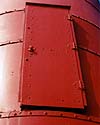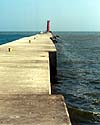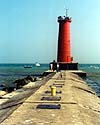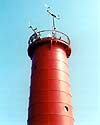 |
 |
 |
 |
| Sheboygan Breakwater Light | Seeing The Light |
|
|
|
|
Historical
Information In the 1830's settlers were already heading into the area from Milwaukee, and a growing fishing village was growing at the river mouth. To help guide vessels into the harbor, the first lighthouse was constructed on Sheboygan Point in 1939. By 1845, at least four local fisheries were in operation, shipping salted whitefish to the growing cities to the south and on the East Coast. After a local merchant constructed a wooden pier in the harbor, maritime business in the area expanded rapidly. While in 1844 the population of the town was a mere seventy-seven residents, only three years later it had grown to over seven hundred. Sheboygan quickly became a hive of shipbuilding activity, with at least seven shipyards flourishing along the banks of the river, with fishing boats, schooners, steamers up to two hundred feet in length, and even a fireboat calling Sheboygan their birthplace. To provide an improved light, the old lighthouse was demolished, and a new improved structure built in the same location. In fact, shipbuilding was such an important component of life in the area that in 1871 a Sheboygan newspaper reported that the City had declared a holiday on the day of the launching of the one hundred and forty-foot tug Bismark. With the construction of improved piers to protect the harbor in the early 1870's, a light was constructed on the end of the north pier in 1873. For unknown reasons, this light burned to the pier in 1880, and three months later construction was completed on its replacement.
Built in 1876 by the Rand and Burger shipyards of Manitowoc, the Cooper was one hundred and thirty-one feet overall, with a beam of twenty-seven feet, a depth of nine feet, and boasted a gross tonnage of two hundred and fifty-two tons. The Cooper departed Pine River, Michigan early the previous day, and was loaded with two hundred and thirty thousand board feet of elm lumber, bound for the Matton Manufacturing Company in Sheboygan. She arrived off the harbor piers close to midnight, and as a result of the howling gale was unable to make her way into the safety of the harbor. While she signaled for a tug to come out and tow her into the harbor, no tug responded.
However, before the lifesavers could get alongside, the Cooper capsized, tossing her crew and much of the lumber stacked on her decks into the water. While the lifesavers made it out to the vessel, the threat of being smashed by the lumber thrashing about in the seas prevented them from rescuing the crew.
The ship broke up and came ashore. With increasing seas, she later washed back into the harbor and went down, out of sight and out of mind.
To prepare for the construction of the new marina in 1992, a survey of harbor was in progress when the ninety-eight year old wreckage of the Lottie Cooper was once again discovered. Realizing the historical significance of the wreck, and the relatively good condition in which the wreck was discovered, the wreckage was removed from the harbor, and placed on shore. The following year, realizing that maritime artifacts of such large size from the age of schooners are a great rarity, the City of Sheboygan decided to display the remains as a museum in the marina. Today, the Lottie Cooper's shattered hull stands as mute witness to Sheboygan's vital maritime past and to the sixty-two ships that sank off the town over the years. Today, the pier light is still in use as an active Coast Guard aid to navigation. Equipped with a white plastic lens, the light is visible for a distance of nine miles. The tower also houses an electrically operated fog signal, which booms for three seconds out of 30. The tower is also topped with an array of weather tracking information, and serves as a National Data Buoy Center, measuring air pressure, wind speed and atmospheric pressure, and electronically transmitting that information twenty-four hours a day. Keepers of this Light It was a beautiful evening as we pulled into the Sheboygan and made our way through the marina towards the pier. The north pier is one of the longest we have walked, and juts perpendicular into the lake to provide the maximum amount of shelter for the harbor. As we walked the length of the pier, there were a number of jet skis running back and forth parallel to the pier, in order to take advantage of the large waves on the open side of the pier. While it was fun to watch them go airborne as they flew over the wave crests, their "supercharged mosquito" buzzing was obnoxious, and ruined an otherwise peaceful walk. On the way back out of the marina, we stopped by the displayed wreck of the Lottie Cooper, and spent a pleasant half hour looking over the remains of this old schooner, and reading her story on the accompanying displays. It was a sobering sight to see such a wreck up close, and amazing to see the size of these old schooners that plied the lakes a century in the past. Finding this
Light
Reference
Sources |
This page last modified 01/25/2002